China cardiovascular diseases report 2018: an updated summary
Li-Yuan MA, Wei-Wei CHEN, Run-Lin GAO, Li-Sheng LIU, Man-Lu ZHU, Yong-Jun WANG,Zhao-Su WU, Hui-Jun LI, Dong-Feng GU, Yue-Jin YANG, Zhe ZHENG, Sheng-Shou HU,#
1National Center for Cardiovascular Diseases, Beijing, China
2Beijing Tiantan Hospital, Beijing, China
3Beijing Anzhen Hospital, Beiing, China
Keywords: Cardiovascular diseases; Heart failure; Risk factors
1 Introduction
Rapid socioeconomic progress has greatly affected the lifestyle in China. Consequently, owing to lifestyle changes,urbanization, and accelerated population aging, the risk of cardiovascular diseases (CVD) has increased. The incidence of CVD has been increasing continuously and this upward trend is projected to continue in the next decade. The growing burden of CVD has become a major public health issue.Accordingly, since 2005, the National Center for Cardiovascular Diseases of China has directed experts in cardiology, neurology, nephrology, diabetes, epidemiology, community healthcare, health economics, biostatistics, and other related fields to prepare the annual Report on Cardiovascular Diseases in China. This report aims to provide a timely review of the growing epidemic of CVD in the country as well as to assess the progress made in its prevention and control. We present herein an updated summary of the Report on Cardiovascular Diseases in China 2018 that includes trends in CVD, the morbidity and mortality of CVD, risk factor assessment, health resources for CVD, and a profile of medical expenditure.
With respect to mortality, two in five deaths in China are attributed to CVD (Figures 1 & 2), higher than the death rate due to cancer or other diseases. CVD remained the leading cause of death in 2015, accounting for 45.50% and 43.16% of all deaths in rural and urban areas, respectively.Further, from 2009 onwards, the CVD mortality rate in rural areas exceeded that in urban areas, and in 2016, the rate was 309.33 per 100,000 people in rural areas and 265.11 per 100,000 people in urban areas (Figure 3).
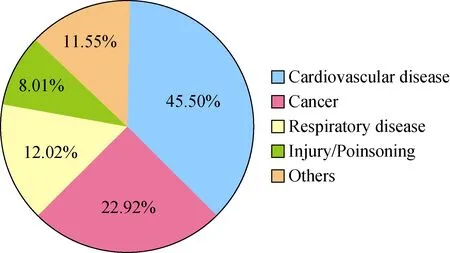
Figure 1. Major causes of death in the rural Chinese population in 2016.
2 Cardiovascular disease prevalence and mortality
The prevalence of CVD in China has been increasing continuously since 2006. Of the approximately 290 million patients with CVD, 13 million, 11 million, 5 million, 4.5 million, 2.5 million, 2 million, and 245 million have stroke,coronary heart disease (CHD), pulmonary heart disease,heart failure (HF), rheumatic heart disease, congenital heart disease, and hypertension, respectively.
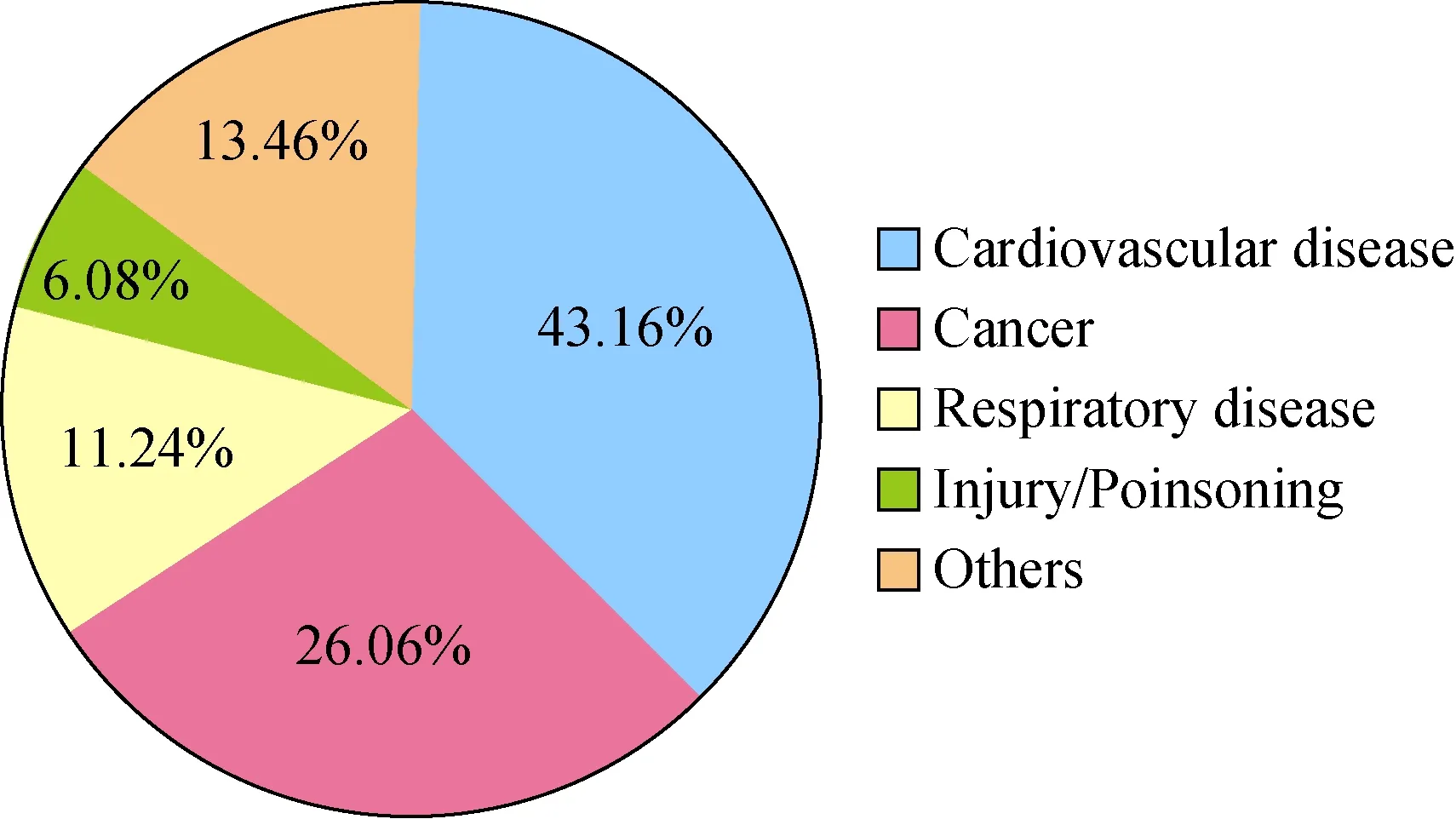
Figure 2. Major causes of death in the urban Chinese population in 2016.
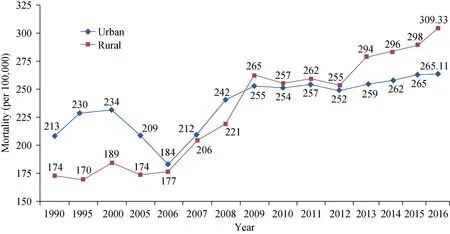
Figure 3. Mortality rates due to cardiovascular disease in urban and rural areas in China: 1990-2016.
3 Risk factors of cardiovascular diseases
3.1 Hypertension
Data from four national surveys on hypertension showed that the prevalence of hypertension in China among individuals aged over 15 years continuously increased from 5.1% in 1958-1959 to 7.7% in 1979-1980, 13.6% in 1991,and 17.6% in 2002. The Survey on the Status of Nutrition and Health of the Chinese People in 2012 showed that 25.2% of adults in China aged ≥ 18 years had hypertension.Using data from the 2010 National Population Census as a denominator, we can estimate that this corresponded to approximately 270 million individuals. The China Hypertension Survey examined 451,755 individuals aged ≥ 18 years from 262 urban and rural areas in 31 provinces, municipalities, and autonomous regions of mainland China in 2012-2015. Using stratified multi-stage random sampling, they found a 27.9% (weighted: 23.2%) overall crude prevalence of hypertension. Further, they found that hypertension was more prevalent in men than in women (crude rate: 28.6%vs.27.2%, weighted rate: 24.5%vs.21.9%), and the prevalence increased with age.[1]Further, this data showed that among Chinese residents aged ≥ 18 years, the overall crude prevalence of high-normal blood pressure was 39.1% (weighted rate: 41.3%). The rates of hypertension awareness, treatment,and control among Chinese adults aged ≥18 years were 51.6%, 45.8% and 16.8%, respectively, and the rate of controlled hypertension among those receiving treatment was 37.5%, higher than the rates observed in previous studies.
The results of the China Health and Nutrition Survey(CHNS) showed that the prevalence of hypertension among juveniles markedly increased from 10% in 1993 to 12.9% in 2011, with an average annual increase of 0.16%. Blood pressure levels increased among all groups of children, irrespective of age or sex. In an analysis of 190,000 Han school-age children (7 to 17 years) by the National Student Health Study in 2010, hypertension was found to be present in 14.5% of children and adolescents (boys: 16.1%; girls:12.9%).[2]A retrospective analysis of hospitalized patients revealed that most children with hypertension (52.0%-81.5%) were admitted for secondary hypertension, and renal hypertension was the leading etiology for secondary hypertension.
3.2 Smoking
Since 1984, China has had one of the highest worldwide rates of smoking among men, with the rate having remained above 50% since 1996. A 2015 survey on tobacco-smoking among adults in China showed that the smoking rate among males remained high at 52.1% in those over 15 years of age,although a declining trend since 1996 was observed. In 2002-2010, the annual decline in the normalized smoking rate was 0.08% on average. The Global Youth Tobacco Survey-China, which examined 155,117 students aged 13-15 years in 2014, reported that 6.9% of Chinese teenagers were current smokers. The prevalence was higher in men than in women (11.2%vs.2.2%) and higher in rural areas than in urban areas (7.8%vs.4.8%).
According to the Global Adult Tobacco Survey in 2010,approximately 738 (72.4%) million non-smokers in China were exposed to secondhand smoke (SHS). However, the proportion of non-smokers who witnessed smoking in indoor workshops, public places, public transport vehicles,and at homes decreased in 2015, indicating that SHS exposure had reduced. The rate of smoking cessation among Chinese individuals aged ≥ 15 years increased from 9.42%in 1996 to 16.9% in 2010. In 2015, it was found that 18.7%of all former and current smokers had become non-smokers.According to the 2104 China Youth Tobacco-smoking Survey of Chinese teenagers, among current smokers, 71.8%had attempted to quit smoking.
3.3 Dyslipidemia
The China Chronic Disease and Risk Factor Surveillance(CCDRFS) study examined 163,641 adults from 31 provinces, municipalities, and autonomous regions in China during 2013-2014. The average levels of serum total cholesterol (TC), low-density lipoprotein cholesterol, triglyceride, and high-density lipoprotein cholesterol among Chinese individuals aged ≥ 18 years were 4.70, 2.88, 1.14, and 1.35 mmol/L, respectively.[4]The level of serum TC observed was significantly higher than that noted in the 2002 CHNS (3.81 mmol/L) and 2010 CCDRFS (4.04 mmol/L).
Data from the CHNS, Chinese National Survey of Chronic Kidney Disease (CNSCKD), and Report on the Nutrition and Chronic Disease Status of Chinese Residents(2015) showed that the prevalence of dyslipidemia in Chinese individuals aged ≥ 18 years increased substantially during the last decade, from 18.6% in 2002 to 34.0% in 2010 and 40.4% in 2012. The 2010 CNSCKD, a cross-sectional study of 43,368 urban and rural residents from 13 provinces and municipalities in mainland China,[4]showed that the rates of dyslipidemia awareness, treatment, and control among people aged ≥ 18 years were 31.0%, 19.5%,and 8.9%, respectively. These rates were also lower in men than in women (30.12%vs.31.84%, 18.90%vs.20.01%,and 7.27%vs.9.62%, respectively).
3.4 Diabetes
According to a nationwide epidemiological study performed in 2013, the overall standardized prevalence of diabetes in Chinese adults was approximately 10.9%, and the rate was slightly higher in men than in women (11.7%vs.10.2%). When diabetes was diagnosed according to hemoglobin A1c (HbA1c) concentration was considered, the prevalence increased by 0.5%. Prediabetes was prevalent in approximately 35.7% of individuals. Among those with diabetes, 36.5% were aware of their condition, 32.2% were treated, and 49.2% of the treated patients had adequate glycemic control.[5]
The China Kadoorie Biobank (CKB) was a 7-year nationwide prospective study of 512,869 adults aged 30-79 years.[6]The results showed that adults with diabetes had a significantly higher risk of all-cause mortality than those without diabetes. The presence of diabetes was associated with increased mortality from ischemic heart disease and stroke. Similarly, diabetes was associated with an increased relative risk of mortality from chronic liver disease; infections; and cancer of the liver, pancreas, female breast, and female reproductive system. The increase in mortality due to CVD was the most prominent. Aside from the low treatment and control rates of diabetes, the low use of cardioprotective medications also contributed to the high cardiovascular mortality in patients with diabetes. The CKB estimated that there was a median loss of 9 (rural 10, urban 8)years of life for individuals with diabetes diagnosed before the age of 50 years.
3.5 Overweight and obesity
Data from the Report on the Nutrition and Chronic Disease Status of Chinese Residents (2015) demonstrated that in 2012, 30.1% of Chinese residents aged ≥ 18 years were overweight and 11.9% were obese. This increased by 7.3%and 4.8%, respectively, compared with the prevalence in 2002. Although the rates of overweight and obesity in 2012 were lower among rural residents, the increase observed was higher than that in their urban counterparts. The mean waist circumference and the prevalence of abdominal obesity also increased among Chinese adults. Here too, the increase was greater in rural residents, indicating a decrease in the disparity between the two populations.
The prevalence of overweight and obesity also increased in children (0-17 years) in both urban and rural areas, with the rate being significantly higher in 2012 than that in 2002.The National Physical Fitness survey, a health surveillance survey for Chinese school-age students, was conducted six times during 1985-2014. In 2013, more than 120,000 students aged 7-18 years were selected from seven major geographic areas in China using stratified random cluster sampling. Overweight and obesity were prevalent in 12.2% and 7.1% of these children, respectively. Furthermore, the prevalence rates of overweight and obesity in this group also showed an increase, being 11 and 56 times higher, respectively, in 2014 than in 1985.
3.6 Physical inactivity
The results from the CHNS demonstrated a significant decline in overall physical activity (PA) in Chinese residents aged 18-60 years during 1991-2011. Such a decline was largely driven by occupational PA reduction. PA decreased by 31% from 382 metabolic equivalent of task (MET)-h/week in 1991 to 264 MET-h/week in 2011 among adult men and by 42% from 420 MET-h/week to 243 MET-h/week among adult women. The number of participants (including children and adolescents) engaging in regular PA increased by 5.7% in 2014 compared with that in 2007 (33.9%vs.5.7%). However, the rate of regular PA participants was still low among young adults aged 20-49 years.
The 6thNational Physical Fitness study, a health surveillance survey of Chinese school students, was conducted among more than 220,000 students aged 9-22 years in 2014.The results showed that the prevalence of PA time < 1 h was higher in girls than in boys (73.3%vs.79.1%). The prevalence of inactivity increased with age for both sexes.Data from the 2016 Physical Activity and Fitness in China-The Youth Study conducted among more than 90,000 students aged 9-17 years showed that 29.9% of the participants met the recommended PA guidelines, with the percentage being higher in boys than in girls (31.8%vs.28.2%).[7]
3.7 Diet and nutrition
The CHNS showed that the dietary patterns in China changed significantly during 1982-2012. With respect to the three major caloric nutrients, the intake of protein barely changed, but that of fat and carbohydrates significantly increased and decreased, respectively. In general, the total calorie intake decreased substantially. In 2012, the average percentage of calories obtained from dietary fat was 32.9%, exceeding the upper limit of 20%-30% recommended by the Dietary Guidelines for Chinese Residents (2016).Meanwhile, the calorie intake from carbohydrates decreased to a nationwide average of 55%, meeting the recommended limit of 55%-65%. In addition, the consumption of vitamin C, calcium, and potassium also declined. Dietary sodium intake reduced markedly, but remained high at 5702 mg/day(corresponding to salt intake of 14.5 g/day) in 2012, which was more than twice the amount recommended in China (<6 g/day) and by the World Health Organization (< 5 g/day).The imbalance in calorie intake from dietary nutrients was more serious in urban residents than in those living in rural regions.
3.8 Metabolic syndrome
The 2002 CHNS reported that of adults aged ≥ 18 years,prevalence of the metabolic syndrome (MS) was 6.6%based on the criteria from the China Diabetes Society and 13.8% based on the US National Cholesterol Education Program-Adult Treatment Panel III (NCEP-ATP III). The 2010 China Noncommunicable Disease Surveillance study examined 98,658 adults aged ≥ 18 years from 31 provinces,municipalities, and autonomous regions of mainland China.MS was identified according to the ATP III criteria, and the prevalence rate was 33.9%, significantly higher than that in 2002.[8]
3.9 Air pollution
Findings from the Global Burden of Disease Study 2010 showed that atmospheric and indoor air pollution were the fourth and fifth leading risk factors, respectively,[9]for increased age-standardized disability-adjusted life years (DALY)in China. The concentrations of PM2.5, SO2, NOx, and total suspended particles were positively correlated with the incidence of CVD and the mortality caused by it. Between 2010 and 2012, the mean daily PM2.5concentration was 96.2 μg/m3in Beijing, and a 10 μg/m3increase in PM2.5concentration was associated with a 0.27% increase in ischemic heart disease (IHD) morbidity.
The long-term effect of atmospheric pollution on CVD was even greater. A cohort study in Hong Kong analyzed the relationship between baseline exposure to atmospheric particulates and CVD mortality in 66,820 residents aged≥ 65 years. After 10-13 years of follow-up, it was found that with every 10 μg/m3increase in PM2.5, the risk of mortality from CVD, IHD, and ischemic stroke increased by 22%, 42%, and 21%, respectively.[10]In 2013, 807,000 deaths in China were attributable to indoor air pollution,including 169,000 from hemorrhagic stroke, 152,000 from IHD, and 88,000 from ischemic stroke. Compared with the rate in 1990, the total number of deaths and DALY due to indoor air pollution decreased by 24.5% and 42.4%, respectively.[11]
4 Cardiovascular disease statistics
4.1 Cerebrovascular disease
Data from the China Health and Family Planning Statistics Yearbook (2017) showed that the mortality of cerebrovascular disease was still increasing in 2016 (Figure 4).Compared with that in 2015, the mortality declined slightly in urban areas (126.41/100,000vs.128.23/100,000), whereas it markedly increased in rural areas (158.15/100,000vs.153.63/100,000). In general, the mortality rate was higher in men than in women and higher in rural areas than in urban areas.
The China National Stroke Screening Survey showed that in 2014, stroke was prevalent in 2.06% of adults aged >40 years. The most significant contributor to stroke was hypertension, followed by family history, dyslipidemia,atrial fibrillation, diabetes, physical inactivity, smoking, and obesity. The incidence of first-ever stroke in adults aged 40-74 years increased at an annual rate of 8.3%, from 189/100,000 in 2002 to 379/100,000 in 2013. The mortality of stroke in adults aged 40-74 years remained stable during 2002-2013, at approximately 124 /100,000.
4.2 Coronary heart disease
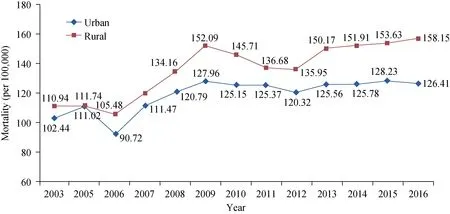
Figure 4. Mortality rates due to stroke in urban and rural areas in China: 2003-2016.
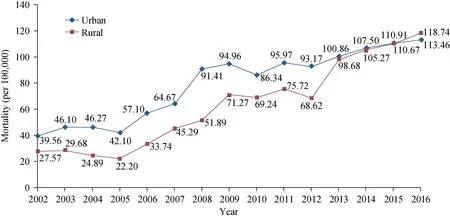
Figure 5. Mortality rates due to cardiovascular disease in urban and rural areas in China: 2002-2016.
According to data from the China Health and Family Planning Statistics Yearbook (2017), the mortality of CHD in 2016 was still increasing in both urban and rural areas(Figure 5). It was 113.46/100,000 for urban and 118.74/100,000 for rural residents. Overall, the mortality rate of CHD was higher in men than in women and higher in rural areas than in urban areas.
Acute myocardial infarction (AMI) mortality increased between 2002 and 2016, with a rapid increase observed from 2005 onwards. AMI mortality in rural areas exceeded that in urban areas in 2007, 2009, and 2011, markedly increased in 2012, and significantly exceeded that in urban areas in 2013 and 2016 (Figure 6). Mortality from AMI increased with age regardless of sex or urban/rural distinction and increased most significantly after the age of 40 years.
4.3 Heart rhythm disorders
A 2004 survey of 19,363 participants aged ≥ 35 years from 10 different regions in China (four towns and six rural areas) showed that the age-adjusted prevalence of atrial fibrillation (AF) was 0.77% (0.78% for men and 0.76% for women). A stratified multi-stage random sampling survey of 31,230 community residents in 31 provinces, municipalities, and autonomous regions of mainland China showed that AF was prevalent in 0.71% of adults aged ≥ 35 years.The application of radiofrequency catheter ablation (RFCA)increased during 2010-2017 at an annual rate of 13.2%-17.5%. The number of RFCAs performed reached up to 133,900 in 2017. Among all patients undergoing RFCA, the proportion of those who underwent RFCA for AF increased annually from 21.0% in 2015 to 23.1% in 2016 and 27.3%in 2017.

Figure 6. Mortality rates due to acute myocardial infarction in urban and rural areas in China: 2002-2016.
Statistics from the National Health Commission’s online registration system show that 76,717 pacemakers were implanted in 2017, with an increase of 4.98% over the previous year. The proportion of dual-chamber pacemakers implanted was approximately 73%, with an increase of 4%compared with the data from 2016. The number of implantable cardioverter-defibrillator (ICD) implantations has been increasing continuously in recent years at an annual growth rate of > 10%. In 2017, 4092 ICDs were implanted,and the proportions of single- and dual-chamber ICD implantations were 37.7% and 62.3%, respectively, with little variation from the values in 2016. The proportions of ICD implantation for primary and secondary prevention were 44.5% and 55.5%, respectively. In total, 4138 cardiac resynchronization therapies (CRTs) were performed in 2017,an increase of 29.3% and 16.2% compared with that in 2016 and 2015, respectively. The rate of CRT-D implantation was also observed to be increasing yearly.
4.4 Heart failure
A survey of 15,518 people from 20 urban and rural areas in 10 provinces in China demonstrated that in 2000, chronic HF was prevalent in 0.9% of the Chinese population aged 35-74 years (0.7% in men and 1.0% in women). The prevalence was higher in the north than in the south (1.4%vs.0.5%) and higher in urban areas than in rural areas (1.1%vs.0.8%). The prevalence of HF increased significantly with age. The China Heart Failure Registry Study (China-HF)[12]analyzed clinical data from 8516 patients with HF during 2012-2014. The results showed an upward trend in the average age of hospitalized patients with HF. Hypertension and CHD had become the main causes of HF in China, and infection was the most common trigger of HF. The mortality of hospitalized patients with HF was 4.1%, which was significantly lower than those reported in previous studies.
4.5 Pulmonary disease
The China Pulmonary Health study evaluated 50,991 participants who had reliable post-bronchodilator results between June 2012 and May 2015. The results showed that the prevalence of COPD was 8.6%,[3]accounting for 99.9 million people with COPD in China. The National Cooperative Project for the Prevention and Treatment of Venous Thromboembolism conducted a registry study during 1997-2008. They evaluated 16,972,182 patients with pulmonary embolism (PE) admitted to any of the > 60 Grade-III Class-A hospitals and found an annual PE incidence of 0.1%.[14]
4.6 Cardiovascular Surgery
In 2017, 228,938 cardiac surgeries were performed in mainland China. Of these, 162,597 were performed onpump, accounting for 71% of such surgeries. In the same year, 77,305 operations for congenital heart diseases, 65,749 surgical inventions for valvular heart diseases, 45,455 coronary artery bypass grafts, and 19,585 aortic surgeries were performed in mainland China and Hong Kong, with 2002 patients supported by extracorporeal membrane oxygenation. The number of heart transplants in China has been increasing for the past 10 years. In 2017, 559 heart transplants were completed, and 32,126 patients with congenital heart disease were treated with interventional therapy in mainland China. The overall success rate was 98.6%. According to the 2011 China Health Insurance Research data,the annual incidence of acute aortic dissection in mainland China was approximately 2.8/100,000. The incidence was significantly higher in men than in women (3.7/100,000vs.1.5/100,000,P< 0.001).[15]
4.7 Chronic kidney disease
A nationwide survey conducted between September 2009 and September 2010 showed that the overall prevalence of chronic kidney disease (CKD) was 10.8% among adults aged >18 years. The prevalence of estimated glomerular filtration rate < 60 mL/min per 1.73 m2was 1.7% and that of urinary albumin/creatinine ratio > 30 mg/g was 9.4%,implying that approximately 120 million individuals in China had CKD. According to the annual report from China Kidney Disease Network,[16]CVD is present in 27.8% of hospitalized patients with CKD, with CHD being the most common CVD (17.7%), followed by HF (13.0%) and stroke(9.2%).
4.8 Peripheral arterial disease
Lower extremity atherosclerotic disease (LEAD) is common among the middle-aged and older population. The major cause of LEAD is atherosclerosis. Cerebrovascular disease and IHD are present in 30% and 25% of patients with LEAD, respectively. The prevalence of LEAD varies widely among different populations, ranging from 2.1% to 27.5%.The China National Stroke Prevention Project reported that 84,880 residents aged ≥ 40 years from 31 provinces, municipalities, and autonomous regions of mainland China underwent carotid ultrasonography. The overall prevalence of carotid atherosclerosis was 36.2%. Approximately 26.5% of participants had increased intima-media thickness(≥ 1 mm), and 13.9% presented plaques.
The Taiwanese Healthcare Insurance program reported that the incidence of renal vascular disease in the overall population of 23 million was 6.69/100,000 person-years.The temporal trend in incidence decreased annually from 2000, and this was mainly attributed to the decline in the incidence of renal artery stenosis among the middle-aged and older population. Further, such decrease was consistent with the increased control rate of atherosclerosis in Taiwan.[17]
4.9 Assessment of medical care quality for CVD
Although the quality of medical care for CVD in China has rapidly improved in recent years, some shortcomings remain to be addressed. The China Patient-centered Evaluative Assessment of Cardiac Events study demonstrated that among patients with AMI, the percentage of evidencedbased medication and percutaneous coronary interventions according to the Chinese Society of Cardiology guideline recommendations increased in 2011 compared with that in 2001. Meanwhile, the percentage of thrombolysis decreased.The in-hospital mortality did not markedly decrease due to delayed visit time and a low reperfusion rate.[18]
5 Community-based prevention and control of CVD
In China, the community-based management of CVD has been investigated and implemented for the last 40 years.With a national comprehensive intervention strategy for the prevention and control of hypertension, the communitybased management of CVD in China is moving forward from the process of exploration and has achieved notable success.
A low-cost comprehensive intervention study was conducted in patients with hypertension from rural areas in Fuxin City, Liaoning Province, with each village considered as a unit. Patients were randomly divided into three groups:the health education group, the elementary intervention group,and the comprehensive intervention group. The aim was to explore the effect of comprehensive intervention on the reduction in CV events. By the end of the 15-month follow-up,the mean blood pressure decreased by 16.07/9.42 mmHg,and the rate of hypertension control increased significantly from 1.1% at baseline to 33.1%. The total risk of CVD and stroke was 55.9% and 55.2% lower in the medication group than in the health education group, respectively.
6 Medical treatment and expenditure on CVD
The number of patients with CVD or diabetes discharged from hospitals in China has been increasing since 1980.Correspondingly, the total expenditure on hospitalization for CVD has also increased rapidly. In 2016, 20.0219 million patients with CVD were discharged from hospitals, accounting for 12.57% of the total number of discharges during this period. Among the discharged patients, 10,026,300 had heart diseases, accounting for 6.30% of this group,whereas 9,995,600 had cerebrovascular disease, accounting for 6.27%. Among the discharged patients with CVD, IHD(7,382,400) and cerebral infarction (6,403,000) were the leading causes of hospitalizations, accounting for 36.87%and 31.98% of all admissions, respectively. Other causes included hypertension (2,407,000) and intracranial hemorrhage (1,429,100).
From 1980 to 2016, the average annual growth rate in the number of discharged CVD patients in China was 9.85%,higher than that for the number of patients discharged overall (6.33%) during this period. Among the various CVDs,cerebral infarction (12.16%) showed the highest annual average growth rate, followed by IHD (11.42%), AMI(10.73%), intracranial hemorrhage (9.48%), hypertension(7.45%), hypertensive heart disease and kidney disease(5.77%), and rheumatic heart disease (1.20%). Meanwhile,the annual average growth rate for diabetes was 13.59%during 1980-2016. In 2016, the hospitalization cost was 19.085 billion RMB for AMI, 25.419 billion RMB for intracranial hemorrhage, and 60.105 billion RMB for cerebral infarction. The average annual growth rates of hospitalization cost for these three major CVDs from 2004 onwards were 29.15%, 16.88%, and 22.24%, respectively. In 2016,the average cost of each hospitalization for AMI, intracranial hemorrhage, and cerebral infarction was 26056.9,17787.0, and 9387.0 RMB, respectively, showing annual growth rates of 7.12%, 5.90%, and 2.30%.
7 Conclusions
The National Center for Cardiovascular Diseases of China continuously monitors and evaluates sources of data on cardiovascular disease in China to provide the most current information annually. This annual report is the product of the effort of numerous physicians, scientists and government professional. Their contributions are gratefully appreciated.
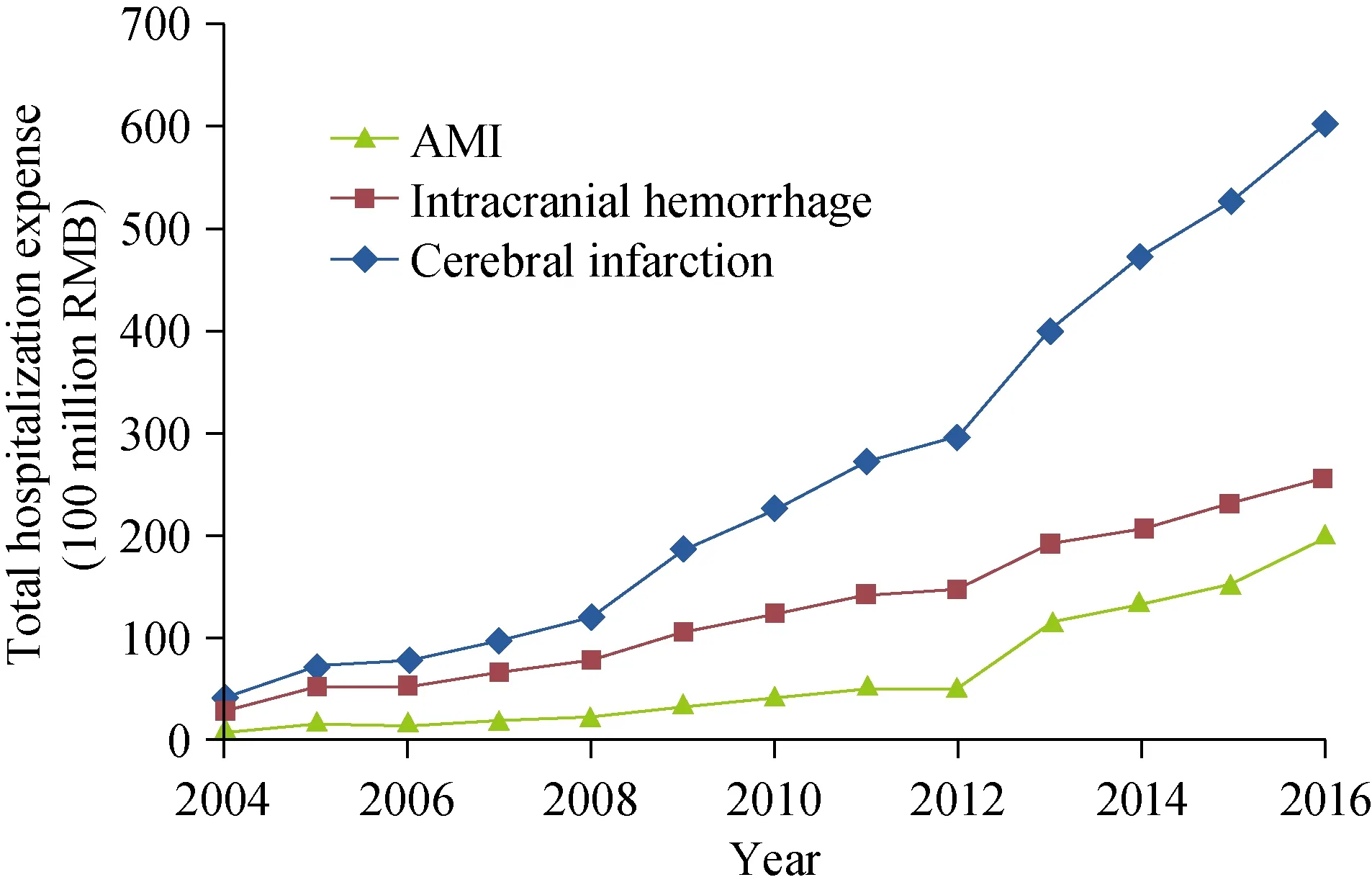
Figure 7. Trend of hospitalization expenses for CVD in China:2004-2015. AMI: acute myocardial infarction; CVD: cardiovascular disease.
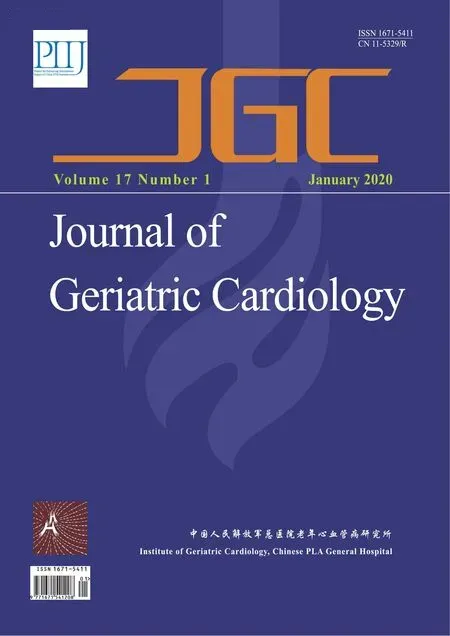 Journal of Geriatric Cardiology2020年1期
Journal of Geriatric Cardiology2020年1期
- Journal of Geriatric Cardiology的其它文章
- Polymorphic ventricular tachycardia during phase II cardiac rehabilitation in a patient with heart failure: a case report
- “One-man” bailout technique for high-speed rotational atherectomy—assisted percutaneous coronary intervention in an octogenarian
- Aspergillus infection of pacemaker in an immunocompetent host: a case report
- Is dual therapy the correct strategy in frail elderly patients with atrial fibrillation and acute coronary syndrome?
- A meta-analysis of 1-year outcomes of transcatheter versus surgical aortic valve replacement in low-risk patients with severe aortic stenosis
- Anemia in patients with high-risk acute coronary syndromes admitted to Intensive Cardiac Care Units
